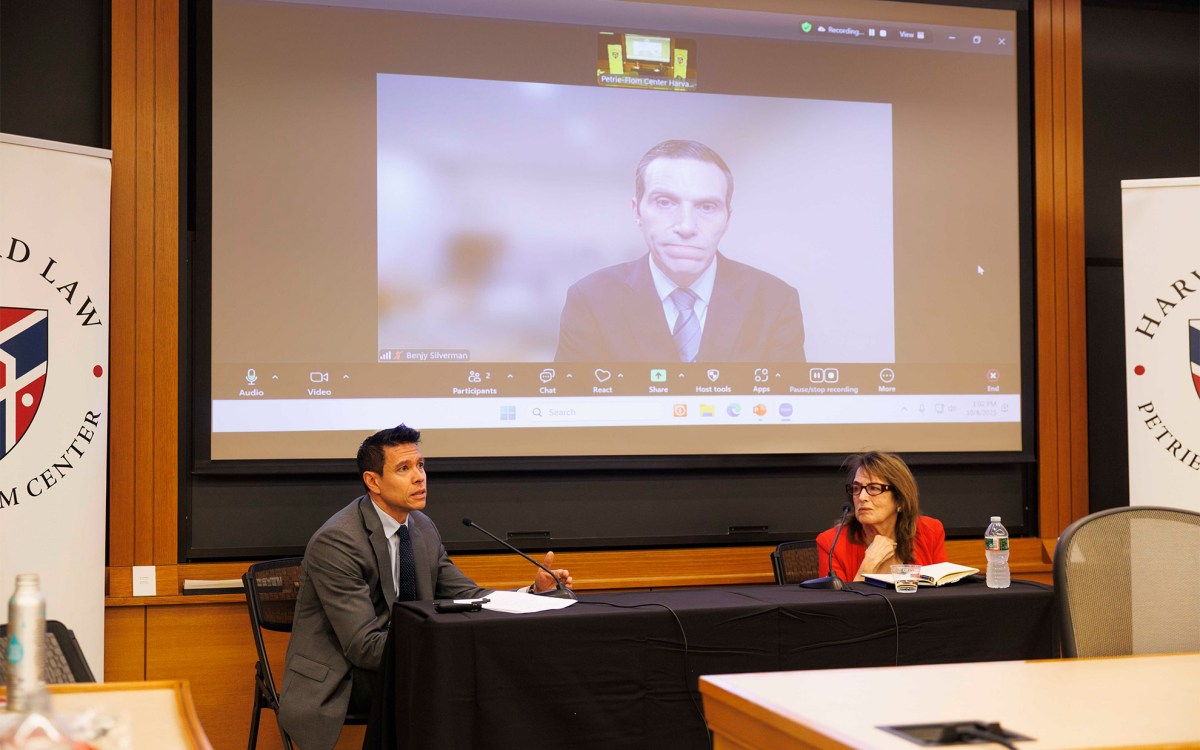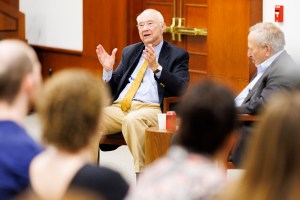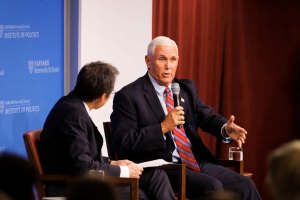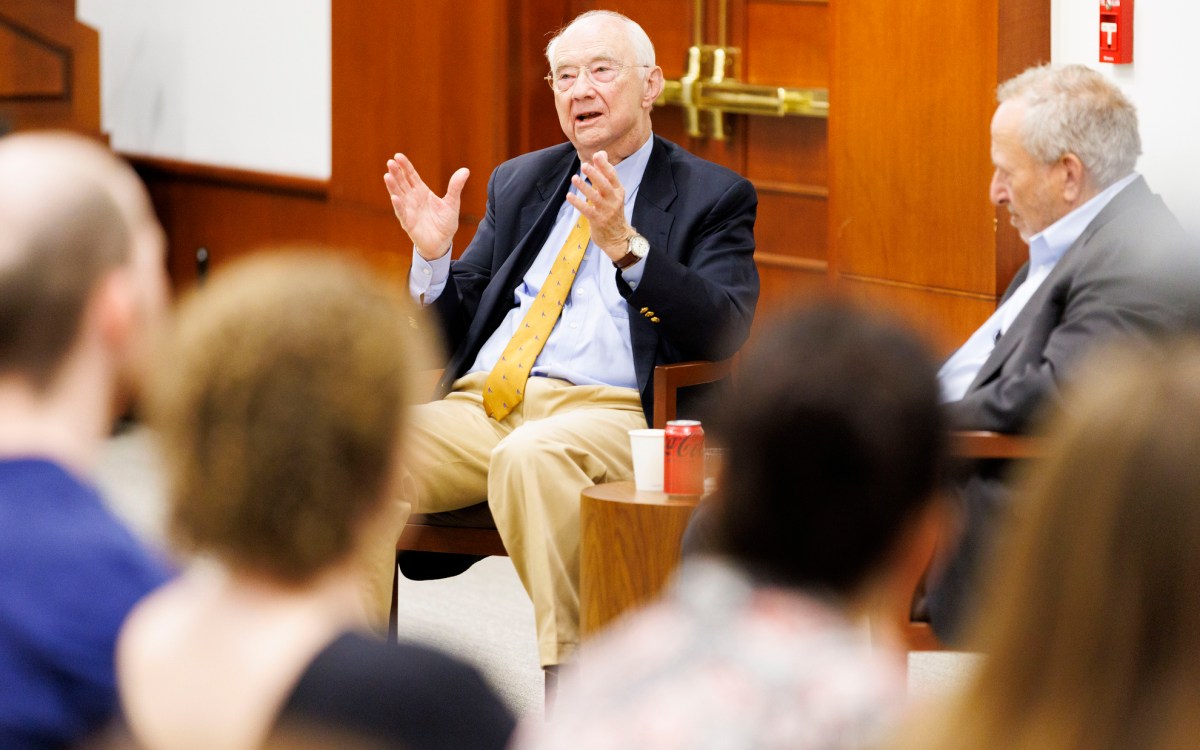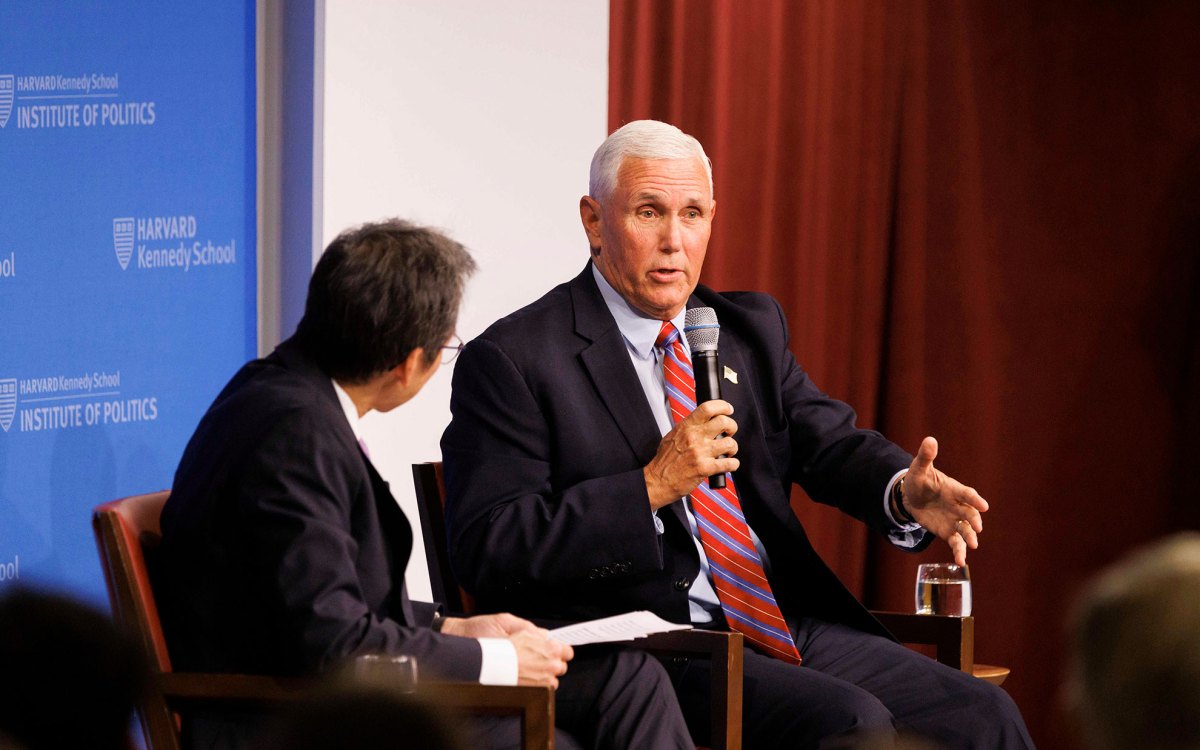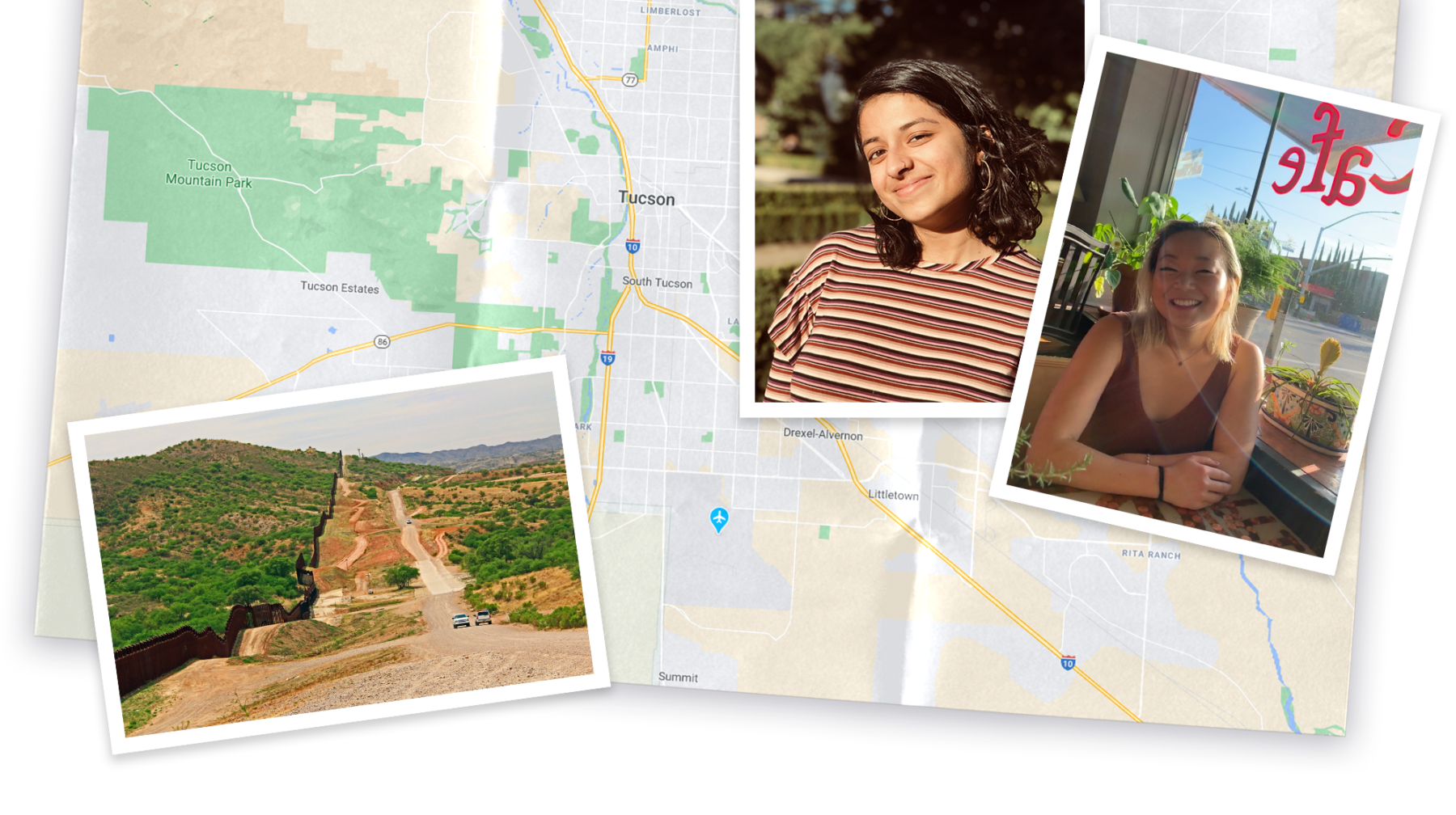
“I would not have the same perspective at all on how to make different kinds of social change, how to ask questions about social change, had it not been for the summer in Arizona,” says Vivekae Kim.
Photos courtesy of Vivekae Kim, Meena Venkataramanan, and from iStock
Through lines
“These are just human stories, and these people are caught up in a very complex system.”
About 370 miles of the U.S.-Mexico border stretches between Arizona and Mexico through the vast, hot Sonoran Desert. Just north of the line lie the Arizona borderlands, the in-between place traversed by migrants hoping to make a new life in the United States, risking dehydration, deportation, detention, and death.
The borderlands and nearby Tucson are also home to a vibrant community of activists and advocates working tirelessly to support migrants, including those who enter the U.S. seeking asylum with few resources or protections.
“Tucson has such a rich migration, immigrant justice, activism, history, and … faith based activism,” says Vivekae Kim, A.B. ’21, one half of the journalism duo that founded the immigration-focused project “Stories from the Border,” initially funded through the Mindich Service Fellowship Program.
Kim and co-founder Meena Venkataramanan, A.B. ’21, didn’t even know each other before the fellowship, and neither expected to work on a joint project. But upon meeting it didn’t take long for them to discover how much they had in common: an interest in advocacy work and law, a pull toward immigrant stories partly inspired by their own families’ experiences, and a shared background in journalism.
For Kim and Venkataramanan, spreading awareness — both around the legal complexities of the immigration system and the diversity of migrant experiences — is key to creating meaningful change in the borderlands and in U.S. immigration policy broadly.
“There are so many different kinds of exclusions and so many different kinds of restrictions and different kinds of abuses towards people who are migrating,” says Kim, whether that’s access to legal representation, detention center abuses, or child separation policies. But she has ideas about how that could change: “The system of immigration would seem less chaotic and less like a system you can’t intervene in to change if people had more history, a better historical background.”
Venkataramanan, who grew up in the borderlands of Southern Arizona, agrees with Kim about the importance of bringing these stories to light. “There’s not necessarily nuanced coverage of immigration as it pertains to local and regional issues … we thought there was fertile ground for possibly establishing our own publication.”
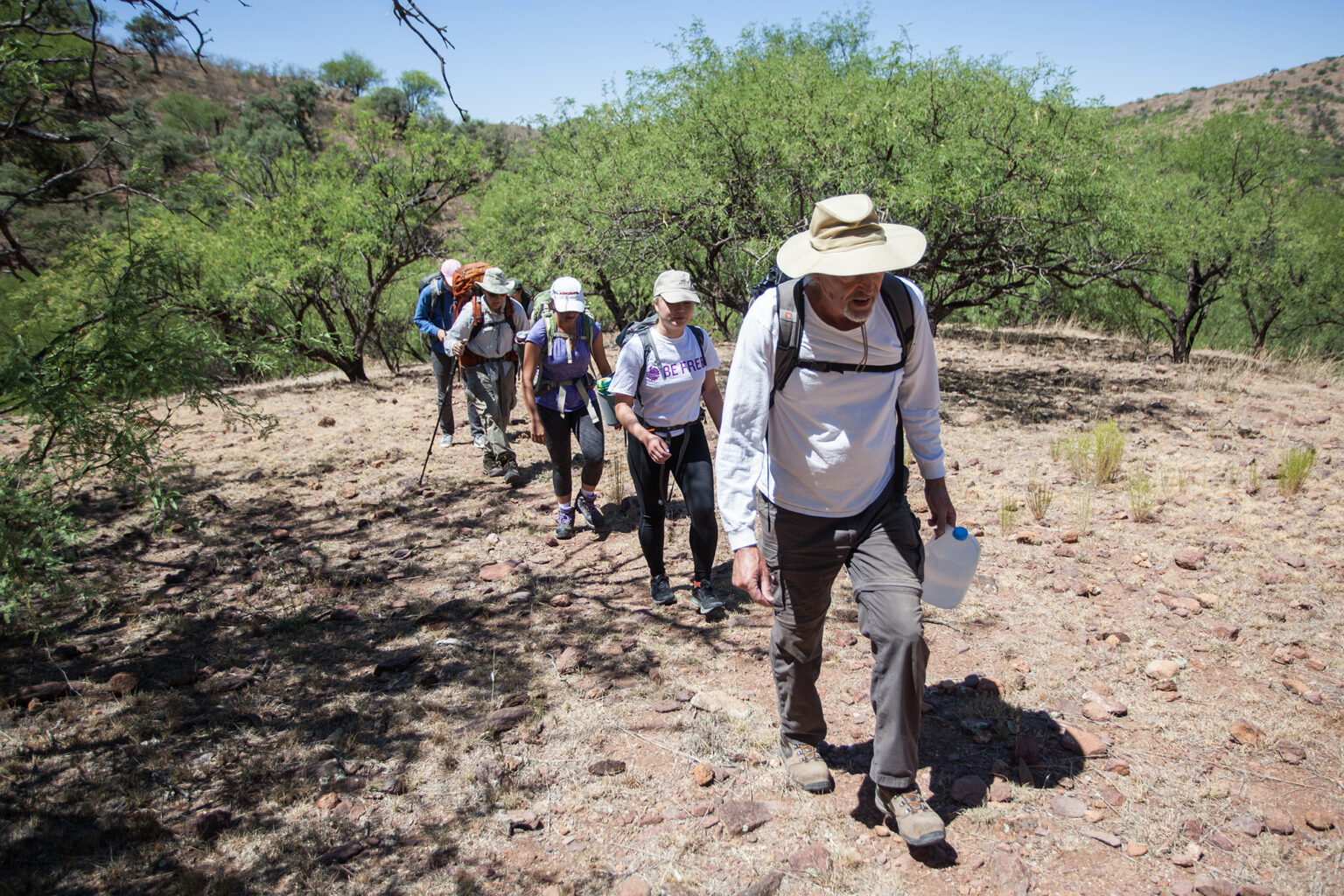
Venkataramanan and Kim accompany local volunteer group Tucson Samaritans on a trip through the Sonoran Desert to drop jugs of water for crossing migrants.
Photo courtesy of Kai McNamee
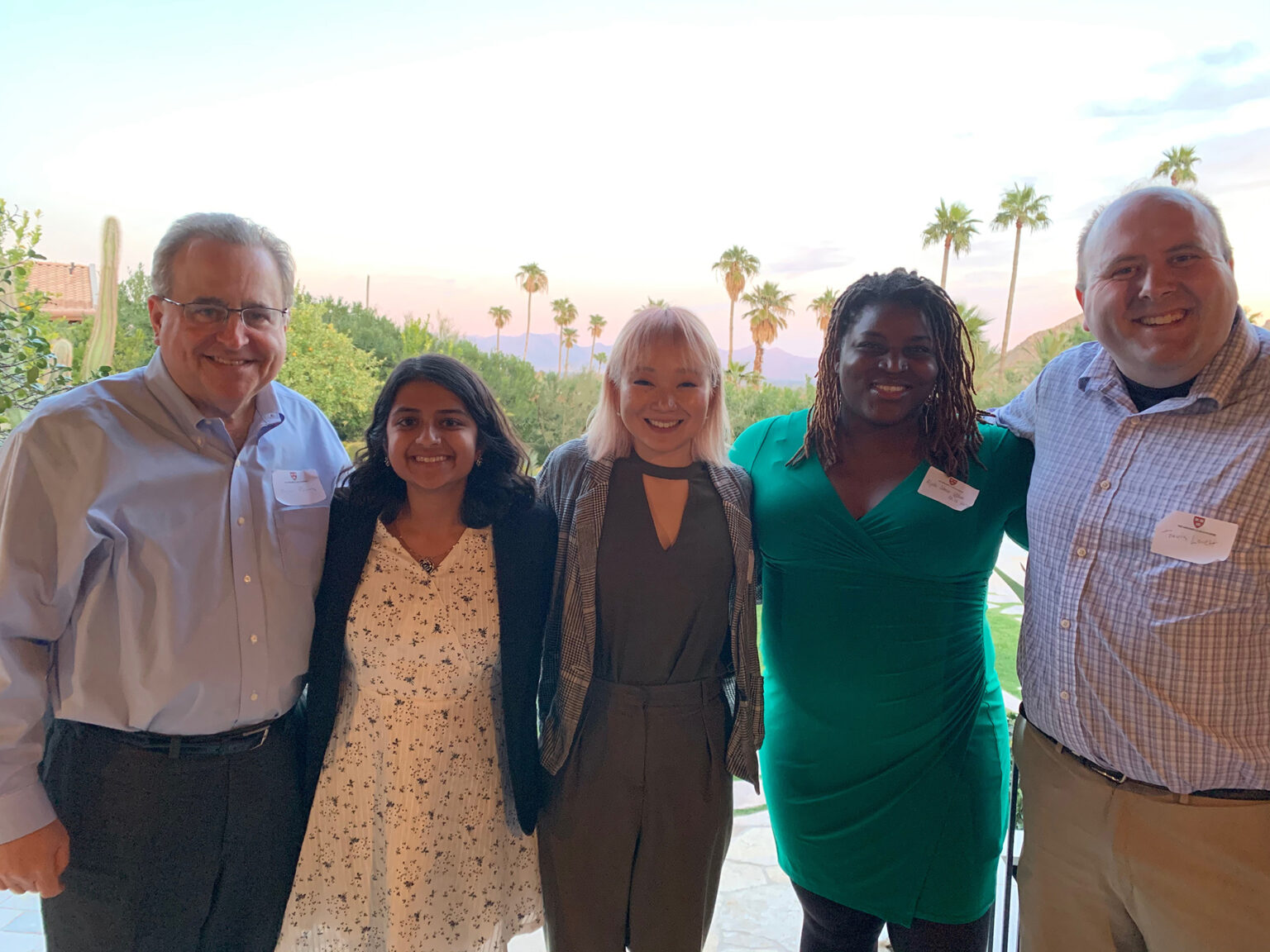
Venkataramanan and Kim (center) with Travis Lovett and Alysha Johnson-Williams from Phillips Brooks House and Michael Brown, Harvard Board of Overseers’ President, in Phoenix, AZ after Venkataramanan and Kim presented Stories from the Border project to the Harvard Club of Phoenix.
Photo courtesy of Meena Venkataramanan
“Stories from the Border” aims for a different kind of storytelling. Hosted on the free publishing platform Medium, the project sets out to explore migration from a variety of perspectives, featuring in-depth articles, a newsletter and article roundup, interactive maps, photo essays, and a recently-launched podcast.
“It’s called ‘Stories from the Border’ for a reason,” says Venkataramanan. “We’re not writing policy papers, or fact statements, [or] briefings, or white papers about what’s happening with immigration. We’re writing actual narratives of the lives this affects. … Every piece of content we’ve produced thus far is something where there’s actual humans in the story that have been affected by immigration.”
Reported stories detail the writers’ experiences sitting with young migrants through hours of immigration court, some of them with no legal representation; venturing into the desert with the volunteer group Tucson Samaritans to drop jugs of water for crossing groups (and speaking with a Border Patrol agent on the issue); and meeting with anxious asylum seekers at the Eloy Detention Center, northwest of Tucson, owned and operated by a private corrections contractor for U.S. Immigration and Customs Enforcement.
“Broadcasts from the boarder”
transcript
Transcript:
Meena: Welcome to Broadcasts from the Border. I’m your host, Meena Venkataramanan. This week, our producer Jess Eng interviews John Morán González, the J. Frank Dobie Regents Professor of American and English Literature at the University of Texas at Austin, where he is also the Director of the Center for Mexican American Studies.
Jess: Professor González is well known for his work on early 20th-century history at the US-Mexico border, and specifically the 1915 to 1920 Borderlands War, which was an undeclared war resulting in some of the worst state-sanctioned racial violence in American history.
Unfortunately, this period is not well known amongst students of history, and if they do learn about it in school, many details are omitted. Today, he shared key background details and the context for this war.
Professor González: What I call the Borderlands War, and what is now known as La Matanza or “The Great Killing” or “Massacre,” stemmed from a series of major changes — political, social, and economic changes — that occurred between 1904 and 1915 in the lower Rio Grande Valley of Texas, which is at the very southern tip of Texas. And what had happened was that prior to 1904, it was part of the South since 1848 at the end of the US-Mexican war with the Treaty of Guadalupe Hidalgo, but essentially the Mexican way of life remained there for another half-century, pretty much undisturbed in many respects.
So in 1904, there’s a major change when a railroad link is built from Corpus Christi and San Antonio down to this part of Texas, effectively plugging in the lower Rio Grande Valley into the national, US national economy. And the changes that stemmed from the speculator opportunity just completely overturned the way of life that had been there for quite a long time. The transition from Tejano-owned largely subsistence cattle ranching economy to an Anglo-controlled corporate agribusiness or agricultural economy. Essentially land is dirt cheap because there’s no water, and land without water is not very useful for the most part.
The Mexican and Spanish settlers, settler-colonists of the region, had a ranching economy. But large-scale irrigation pumps and infrastructure allowed for irrigation, for water to be brought where it hadn’t been before, and hence made this cheap, dry land, much more valuable because it was available for agricultural crops.
Essentially, there’s a very, very rapid turnover of land and also political power. As the railroad companies advertise this part of South Texas with its cheap land and cheap Mexican labor as a kind of California and Florida rolled into one, numerous — thousands, tens of thousands — of Midwesterners essentially come flooded into this area that had never seen such an influx of, of white people, essentially. They come with their Progressive Era Jim Crow beliefs, and hence what they considered to be the corrupt machine politics of the area. They were determined to clean it up.
The first step was effectively disenfranchising the Mexican American vote. They did this through whites-only primaries. They’re quite paranoid because white people in this part of Texas are substantially outnumbered by Mexican-descent people. Along with literacy tests and other poll taxes, all the other kinds of tactics used to disenfranchise mainly African American voters in the South were used in this region as well.
In short order, what you have is the large-scale economic, political, and social displacement of the folks, the Tejanos, who had run the place before. This grew into some major resentments as racial segregation in public accommodations is instituted.
By 1915, this breaks out into a guerrilla war. And I mean that in a very, very literal sense with small bands of say two to three dozen ranchers with hunting rifles are going around attacking farms and railroads and anything that is linked to their displacement. There is an actual shooting war. It’s an uprising with the goal to overthrow the changes of the previous decade.
Of course, this can’t last. It only lasts a couple of months in the summer of 1915, but it is enough to provoke a vicious collective punishment by the law enforcement, particularly the Texas Rangers but aided and abetted often by county-level law enforcement and sometimes vigilantes.
So there’s a just widespread collective punishment of the Mexican-descent population. And our best estimate is that at least a thousand Mexican-descent people are murdered by the state and county authorities. And there were bodies found in the years afterward with execution-style bullet holes in the back of their heads.
Jess: At this point in history, as Professor González describes, border patrol, as we know it today, did not formally exist.
Professor González: At this period, the border is completely open. That is people can cross freely at just about anywhere along the, along the border. And they did.
And the only thing that authorities on either the Mexican or the US side were interested in were customs duties, that is on traffic and goods. So yes, you might have to pay a toll to cross a bridge, but that was pretty trivial. There were no border controls for people per se.
Jess: Increasing racial tension resulted in one of the bloodiest accounts in American history. And yet the Mexican American families who witnessed and experienced this violence first hand responded in dramatically different ways.
Professor González: There were basically two types of reactions by families whose family members were victims of this violence.
One was to attempt to forget it. It was very painful to have a family member murdered in this way. Often these families moved out of Texas, they moved all over. In fact, we had one family who had gone to Michigan. They all said never go to Texas because you’ll get killed there even though they didn’t get related specific circumstances of what happened.
On the other hand, and this is in our work with descendants of murder victims, we find that back when the events happened and also up to the current date, we’re very much involved in seeking some kind of justice for this wrongdoing. These families immediately started archives of documents, of eyewitness testimony, of all kinds of newspaper accounts, because they often filed for compensation in various venues, legal venues, and they had long-standing court cases around these events.
They kept all this stuff, in spare bedrooms and garages. They’ve kept this material for a hundred years. They know these stories very well. It’s a story not simply of, “Oh well, some bad things happened to these folks a long time ago.” But rather how their families and loved ones have continued to fight for justice even after a hundred years. They still feel, I think quite correctly, that that day of reckoning has not been completed.
Jess: Along with four historians, Professor González launched the educational nonprofit Refusing to Forget in 2013. Their goal is simple: retell the story of the borderlands and reclaim it as a part of Texas history. After joining forces, the team sought to create educational experiences around the Texas Rangers and their state-sanctioned violence for a public audience. One of the first places they started looking at was the Bullock Texas State History Museum.
Professor González: We immediately thought but were quite conflicted about going to the Bullock Texas State History Museum because its reputation was as a purveyor of what I call the Chamber of Commerce version of Texas history — very non-critical and overly celebratory. But we also decided that the Bullock was too important not to approach. It is the premier space for public history exhibits in Texas.
When we approached the Bullock leadership, we were actually surprised that they were very receptive to this idea. Really it was about helping them move into what they also saw was the need for more in-depth, critical Texas history exhibits. We were officially the expert consultants on the exhibit. The museum staff created the exhibit, but we had a great deal of input and into the narration, into the curation of the exhibit. And it opened in January 2016.
It ran only for about three or four months, but we had over 40,000 people view it. To us, it is an amazing number, including a lot of K through 12 students taking those Texas history classes. I’ll add one of the kinds of changes in curation we made for the exhibit was to ensure that all the explanatory texts were available in Spanish as well as English because language, of course, indicates who you believe your public to be. And we very much wanted a Spanish-speaking public to be involved.
Jess: Even today, the Texas Rangers are the stars of the latest films, westerns, and pop culture projects. The Texas Rangers are featured favorably in many old and new westerns, including Netflix’s 2019 film The Highwaymen. They are also a popular baseball team and were sensationalized in a 20th-century radio show called Tales of the Texas Rangers.
Professor González: This work of culture and memorialization, of glorification, is really something we’ve seen in the current debates over Confederate monuments. Specifically, how those are not some simply commemorations of great men of the past, but of rather the principles that they stood for both then and now. Essentially placing that Confederate monument in the middle of the town square was the late 19th century white South’s way of asserting a principle, a social principle of white supremacy, and projecting it into public spaces.
The 20th century way is through mass media. And that’s how the Rangers got their glory days, the glorification, cause it really wasn’t until the 1930s. Film, radio, and then later television that the Rangers get glorified and memorialized in a way. So the kind of Walker, Texas Ranger thing. Of course, there were plenty of earlier versions of that. Up until a film made last year or released last year. So there’s been this ongoing, constant kind of glorification, memorialization of the Texas Rangers over the course of a century.
The Texas Rangers were very much involved in the suppression of civil rights efforts by African Americans, such as running the President of the NAACP out of town in the early, about 1920, and then in the late fifties about the violent policing of Black and Brown bodies for the purposes of establishing white supremacy. They’re a very different agency now. They’re primarily investigative, but nonetheless, one can’t ignore this long and pretty bloody history.
Jess: In his reflections on the Bullock exhibit, Professor González notes that the history of the Rio Grande Valley was practically erased from his seventh-grade history book. In it, he also talks about the importance of Texas history to its K through 12 curriculum, and how it’s failed to include the stories and voices from Texas’s most important events.
Professor González: The other place that the Rangers have been memorialized has been in the public school curriculum in Texas, at least. I don’t believe I’m mistaken about this, but Texas is actually the only state that devotes two years of primary K-12 education to state history. So for instance, there are Texas history units or classes at both the fourth-grade level and at the seventh-grade level.
And so back when I was in elementary school, we didn’t have a fourth-grade Texas history, or I sure don’t remember it at least. I think that was a more recent implementation, but there are two whole years devoted to Texas history. And unfortunately, the curriculum has not been updated enough. There’ve been some attempts at pluralism of a kind of a rather empty type.
Jess: On May 25th, 2020 George Floyd, a 46-year-old Black man was killed in Minneapolis, Minnesota. This event spurred present-day protest movements and ongoing conversations about police brutality. In Alex Vitale’s book, The End of Policing, he talks about the problematic history of American law enforcement and specifically comments on the systemic violence from the Texas Rangers. Conversations about police reform today draw connections from the history of the early 20th-century.
Professor González: There are real limits to the discourse of reform. And that is because back in 1919, as a result of this state report, the transcript is like 1500 pages long, the Ranger force was in fact reformed. It was professionalized. They had to be law officers in good standing and post bonds, and so on and so forth. And then the number, the size of the Ranger force was reduced as well.
This was the reform of the day. This didn’t stop the kind of purpose of being. In other words, the kind of size and composition and relative professionalization was changed, but its purpose was not.
They continued for the next let’s see, from 1920, at least through about 1980 or they continued to be involved in the intimidation and violence against people of color. Union busting Chicano farmworkers during the sixties. That was the Texas Rangers. Basically, insofar as you can say like add body cameras or do sensitivity training or kind of implicit bias training or something like that.
But until there’s a collective understanding, and I include the police force within this of what historically their role has been, unfortunately, I think these kinds of, what I might otherwise say are our procedural or technological fixes, are not going to take hold.
Jess: In a time like COVID, Ranger documents, museums, archives, and other primary sources are no longer easily accessible. In line with his work with Refusing to Forget, John offers some of his recommendations and thoughts on learning this history during such an uncertain period.
Professor González: Educational institutions are attempting, scrambling, to try to answer that very sort of question. I think one way is to continue to develop Ethnic Studies as alternatives to the dominant way that US history and culture are taught. Texas, the State Board of Education for K through 12, in the past couple of years adopted both Mexican American Studies and African American Studies. So creating resources for those approved tracks is one way.
Another way is to continue to write our scholarship. In fact, we have a volume coming out in the spring of 2021 called Reverberations of Racial Violence, which is essentially an anthology of scholarly essays about this period and this violence. And as well as publishing op-eds. This stuff is so deeply ingrained that there needs to be a very conscious and long-term effort to root out white supremacy, whatever form it took.
Jess: Refusing to Forget has had many successes, and yet there always remains work to be done. Professor González discussed his dream projects, what it would look like, and how it would take shape.
Professor González: I mean what if we’re able to get an apology resolution from the state, from the state legislature, from the state governor, regarding these events. It would be symbolic, but it would be a hugely important symbolic step towards some semblance of truth and reconciliation. Those two have to go hand in hand.
We’re looking at 2023 as a kind of an interesting date because that’s going to be the bicentennial of the founding of the Texas Rangers and a moment where we definitely want to forestall any further glorification, uncritical glorification. We want to make sure that their role in the establishment of white supremacy in Texas is known. These issues continue to be relevant as we’ve seen in the past few days and weeks.
Meena: This episode was produced and edited by Jess Eng. Thank you to Emily Hong for creating our original music. If you liked this episode, please share it with your friends and follow us on Spotify or iTunes for more content and find us on storiesfromtheborder.org or follow us @borderstoriesAZ on Twitter, Instagram, and Facebook.
During the summer of 2019, Kim and Venkataramanan lived in Tucson, and their stories built on local insights and access provided by relationships with on-the-ground nonprofits, journalists, lawyers, and activists in the area. In those initial meetings and introductions, many of which were facilitated by Phillips Brooks House, Kim recalls asking advocacy groups, locals, and immigration experts about what they felt was missing from immigration media coverage, feedback that helped shape the project.
“[Locals] speak so lucidly about the history of their region, the history of the borderlands as they see it,” says Kim of working with community partners. “They remember when there weren’t so many Border Patrol agents; they remember when there weren’t these integrated fixed towers scanning the desert at night.”
But Kim and Venkataramanan don’t just explore the humanity and perspectives of the people they write about. Their writing often takes a personal lens, offering richly textured narratives describing their respective experiences in the borderlands, while reflecting on their own identities, including as journalists.
“In second grade, no one bothered to tell me I was a different kind of Indian … the kind of Indian whose parents had come from a country on the other side of the world,” wrote Venkataramanan in a piece about visiting the Tohono O’odham Nation, not far from where she grew up, and speaking to three Tohono O’odham women about the border that cuts through tribal lands. “I imagine these are questions the women have answered countless times before, sitting in this very diner,” she acknowledged, “their answers satisfying the hunger of visiting political journalists on encroaching deadlines, erudite magazine writers who hit words together like song.”
And now, more than a year after “Stories from the Border” was first conceived, the project is entering a new chapter. Kim and Venkataramanan have taken on several writing and producing fellows who have their own relationships with migration, and both founders say they hope the project continues to grow, telling migration and immigration stories beyond Arizona and featuring voices from beyond Harvard.
“[Americans] might talk about immigrant experience as one monolithic thing, as like, ‘Oh, I have that typical immigrant story,’” says Kim. “That’s just a complete myth. There’s no such thing as one immigrant story at all.”
This story is part of the To Serve Better series, exploring connections between Harvard and neighborhoods across the United States.
